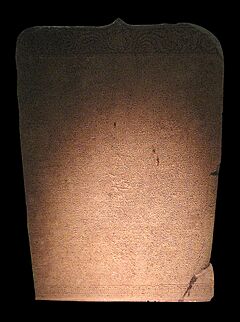Canggal inscription facts for kids
Quick facts for kids Canggal inscription |
|
|---|---|

The Canggal inscription, on display at the National Museum of Indonesia, Jakarta
|
|
| Material | Andesite stone |
| Writing | Pallava script in Sanskrit |
| Created | 732 CE |
| Discovered | Gunung Wukir temple complex in Kadiluwih village, Salam, Magelang Regency, Central Java, Indonesia |
| Present location | National Museum of Indonesia, Jakarta |
The Canggal inscription is an important stone carving from ancient Indonesia. It was made in the year 732 CE. This inscription is written in the Sanskrit language, using a special writing style called the Pallava alphabet.
It was found at the Gunung Wukir temple complex. This place is in Kadiluwih village, near Salam, in the Magelang Regency of Central Java. The Canggal inscription tells us about a powerful ruler named Sanjaya. He declared himself the main ruler of the Mataram Kingdom.
Contents
What Does the Inscription Say?
The Canggal inscription tells a fascinating story. It describes how King Sanjaya ordered the creation of a lingam. A lingam is a special symbol of the Hindu god Shiva. This symbol was placed in a region called Kunjarakunja.
The Island of Java
The inscription says this lingam was set up on the noble island of Yava, which is now known as Java. It describes Java as a rich land. It had lots of grain for food and many gold mines.
Before Sanjaya, Java was ruled by a wise and good king named Sanna. But after King Sanna passed away, the kingdom faced problems. There was a time of confusion and disunity.
Sanjaya Becomes King
During this difficult period, Sanjaya came to power. He was the son of Sannaha, who was King Sanna's sister. Sanjaya was a very skilled person. He had studied holy scriptures and was good at fighting. He also showed great strength in battles.
Sanjaya conquered nearby areas, making his kingdom stronger. After these victories, his rule became peaceful and successful. The inscription tells us that his time as king was very prosperous for the people.
Kunjarakunja and Rishi Agastya
The inscription mentions Kunjarakunja-desa. This might mean "the hermitage land of Kunjara." A hermitage is a quiet place where religious people live. Many experts believe this refers to the hermitage of Rishi Agastya.
Agastya was a very respected Hindu wise man, especially in Southern India. The ancient Indian story, the Ramayana, even mentions this place. It says that Rama, Sita, and Lakshmana visited Agastya's hermitage in Kunjara.
Connection to Other Stories
Interestingly, the names Sanjaya, Sanna, and Sannaha also appear in another old book. This book is called Carita Parahyangan. It was written much later, around the 16th century. Many historians think these names refer to the same historical people. This shows how important these figures were in ancient Javanese history.

